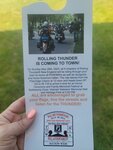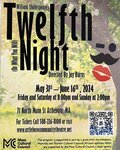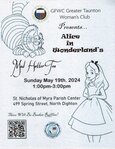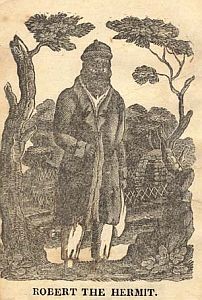Life and Adventures of Robert, Hermit of Massachusetts
Did you know that a former slave named Robert once lived as a hermit in Seekonk? [This area by the Seekonk River later became East Providence, RI.] In the early 1800’s many people knew there was a hermit living by the river, but few knew the details about his sad life until Providence publisher Henry Trumbull interviewed Robert Voorhis and published a short booklet about him in 1829. Trumbull’s biography, written in the more ornate literary style of 200 years ago, also serves as another important piece of New England anti-slavery literature from that time.
As was common in those days, the title of this 36-page booklet is almost as long as the story: “Life and Adventures of Robert, the Hermit of Massachusetts, Who has Lived 14 Years in a Cave, Secluded from Human Society: Comprising, an Account of his Birth, Parentage, Sufferings, and Providential Escape from Unjust and Cruel Bondage in Early Life, and His Reasons for Becoming a Recluse. Taken from his Own Mouth, and Published for His Benefit.”
Reading about the troubles of this former slave makes it clear why he decided to become a hermit in his later years. His turbulent life events included being torn from his birth family and later from his wife and children, betrayal by a false friend, rejoicing in freedom only to know the despair of being dragged back into bondage, then traveling around the world as a sailor, and eventually settling in the Massachusetts/Rhode Island area to live as a recluse.
From Slavery to Freedom
Robert Voorhis was born in Princeton, New Jersey about 1770 to a slave mother and prominent white father. When he was only four years old, he was separated from his mother and sister and given as part of a dowry to his master's daughter, who had married a man named Voorhis, from whom Robert got his last name. He went with them to Georgetown in the District of Columbia.
When he grew up he proposed to a young woman who agreed to marry only if became a free man. Voorhis made an arrangement with a white friend, James Bevins, who agreed to purchase him and allow him to work off the debt. By the time Robert and his wife had children, this so-called friend cruelly betrayed Robert by selling him to a slave trader to take to auction in Charleston, SC. Robert was torn from his loving family, never to see them again.
Robert tried to stow away on a boat heading to Philadelphia, but was caught. He was then sold to a plantation owner where he worked for several months. On his next attempt to escape, he stowed away on a boat heading to New England, where he arrived safely. He was then hired to work on a ship heading to India. For nearly 20 years Robert worked on merchant ships plying their trade between America and Europe and India.
During this time Robert had remarried and had a second family in New England. Upon returning from one of his voyages, he discovered that his second wife had turned against him and wanted nothing more to do with him. He resolved to look again for his first wife and their children in the District of Columbia, but to no avail. He was told that they had died. At this point, he decided to become a hermit. He recalled, “It was at that moment that I formed the determination to become a recluse, and mingle thereafter as little as possible with human society.”
Dwelling in Solitude
Robert had by this time been working for a few years on boats going between Providence and New York. He took up residence on uninhabited land in the Fox Point section of Providence. “There I built me a hut and dwelt peaceably therein for several years, and until annoyed by the youth of the town… I then obtained the consent of the gentleman to whom the land belongs, to build this hut, and… here in solitude I have dwelt more than six years.”
Robert did not live in complete isolation: “Once or twice a week… I leave my recess, cross over the bridge into Providence, converse a little with those with whom I have become acquainted, obtain a few necessaries, and return again well satisfied to my peaceable dwelling,” he told Trumbull.
Trumbull describes Robert as “Content with his situation and at peace with all, he quietly looks forward for the arrival of that day when he shall ‘bid the walking world good night,’ and find in countries unexplored, that happiness which life has denied him.” Robert continued to live as a hermit in Seekonk until he died in 1832.
You can read the entire pamphlet online thanks to the University of North Carolina’s “Documenting the American South” series, which was funded by the National Endowment for the Humanities. The website is http://docsouth.unc.edu/neh/robert/robert.html


















Comments
No comments on this item Please log in to comment by clicking here